
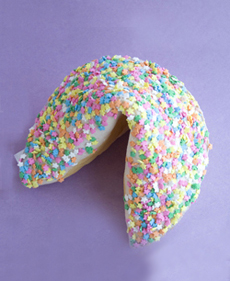 A highly decorated fortune cookie, covered in white chocolate and sprinkles. See our review of Sumo Fortune Cookies. Photo by Claire Freierman | THE NIBBLE.
A highly decorated fortune cookie, covered in white chocolate and sprinkles. See our review of Sumo Fortune Cookies. Photo by Claire Freierman | THE NIBBLE.
July 2010
Last Updated November 2025
|
 |
Types Of Cookies List
Page 3: Florentine, Fortune Cookie & Other Cookie Types Beginning With D To F
Enjoy our extensive list of cookies. This page contains cookie types beginning with the letters D to F, including financier, fondant, and fortune cookie. You can also see the overview of the different types of cookies and the history of cookies—how baked delights came to be. See our many other informative food glossaries—especially the Cake Glossary and Pastry Glossary.
There are thousands of different cookies in the world. This glossary’s objective is to highlight those found in the U.S. Please use the Contact Us link to report any missing entries.
Click on a letter to go to the appropriate glossary page.
a b c d e f g h i j k l m n o p q r s t u v w x y z
This glossary is protected by copyright and cannot be reproduced in whole or in part. You are welcome to link to it.
DANISH BUTTER COOKIE
A butter cookie baked with coconut and topped with a rum-glazed icing.
DIAMANTS
Diamants are a type of sablé butter cookie similar to shortbread (often called a sandy in English). The name of the cookie is “diamond” because when the cookie is rolled in coarse sugar, it looks [poetically] like it has been rolled in diamonds. The cookies in the photo are not rolled in sugar but have bits of chocolate mixed in for even more palate pleasure.
|
|
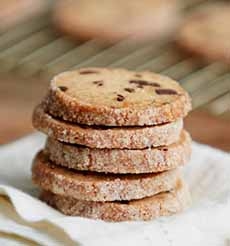
Diamants (photo © American Heritage Chocolate). |
DIGESTIVE BISCUITS
Digestive biscuits are semi-sweet biscuits (Americans would call them crackers or cookies) that were first developed in 1839 by two Scottish doctors to aid digestion. They believed that the sodium bicarbonate they included as an ingredient had antacid properties. The biscuits are made with coarse brown wheat flour, sugar, malt extract, vegetable oil, wholemeal flour, and raising agents like sodium bicarbonate, which gives them their distinctive texture and flavor.
What was meant to help digestion evolved into a snack. Digestive biscuits are like a cross between a cookie and a cracker, with just enough sweetness and a satisfying crunch. They can be eaten plain or with conventional toppings (jam, chocolate or hazelnut spread). The chocolate digestive with a top coat of chocolate, produced by McVitie’s since 1925, was named the most popular biscuit in the U.K. for dunking into tea (in 2009). In the U.K. today, digestive biscuits are frequently eaten with tea or coffee and are also used as crackers with cheese. (We at The Nibble find them superior to slices of baguette when eating fine cheeses.)
The closest American equivalent is the Social Tea Biscuit or graham crackers—although not the mass-produced supermarket brands—they’re a shadow of the original graham cracker. Trader Joe’s version is as close as you can get at a major retailer. Similar equivalents are Rich Tea Biscuits, Maria Cookies /Marie Biscuits, and Petit Beurre Biscuits.
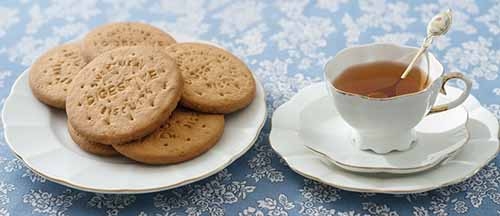
Digestive biscuits and tea, a perfect match (Gemini Photo).
DROP COOKIE
One of the eight basic types of cookies, a drop cookie is a relatively soft dough is dropped by the spoonful onto the baking sheet. During baking, the mounds of dough spread and flatten. Chocolate chip cookies, coconut macaroons, oatmeal cookies, and peanut butter cookies are examples of drop cookies. Depending on the cooking time and recipe, it can be a soft and chewy or crisp and hard cookie. Chocolate cookies, coconut macaroons, peanut butter cookies, and raisin cookies are other traditional drop cookies.
|
|

Oatmeal drop cookies. Photo courtesy Pom Wonderful. |
FAN COOKIE or FANTAIL COOKIE
See gaufrette.
FIG NEWTON
The Fig Newton was named after the town of Newton, Massachusetts; it was the custom of the original manufacturer, Kennedy Biscuit Works of Cambridgeport (now Cambridge, Massachusetts), to name cookies after towns in the Boston area. Kennedy Biscuit Works was affiliated with the New York Biscuit Company, which became part of the company now known as Nabisco. According to Nabisco, the cookie was invented in 1891 by a Philadelphian, James Henry Mitchell, who created the duplex dough-sheeting machines and funnels that made the jam-filled cookies possible. He thought of the soft dough with fruit filling as cookie “pies.”
|
|
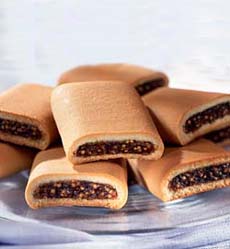
Fig Newtons. Photo courtesy Nabisco. |
The machine was patented in 1892, and Mitchell approached the Kennedy Biscuit Company to try it out. They were impressed—all that was needed was a name. Newton, Massachusetts, got the honor. Just think: We could have Fig Lowells or Fig Naticks instead.
FINANCIER
A cookie-sized rich French almond tea cake made from a sponge-like batter of brown butter, egg whites, flour, toasted ground almond,s and powdered sugar. Financiers were created by a baker named Lasne in the financial district of Paris in the 1890s. Named for the rich financiers who frequented his bakery, Lasne created the little unglazed cake as finger food, to be enjoyed without utensils, and to be non-crumbly—no risk to the suit, shirt or tie of the nibbler. Financiers were traditionally baked in the shape of gold bars, but the rectangular shape was not as attractive as other shapes. A boat-shaped mold became favored, and today the cake can take any shape that appeals to the baker, from an octagon to the fluted circle in the photo. In recent years, financiers have been elevated from breakfast and tea cake to the dessert menus of fine restaurants, with a variety of elegant garnishes.
|
|
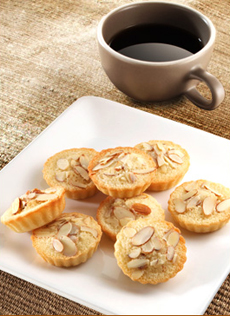
Financiers or French almond cakes were originally baked in the shape of gold bars. Photo courtesy of Donsuemor.com. |
FLORENTINE COOKIE or ALMOND LACE COOKIE
Florentines are crisp, delicate cookies that are pliable when taken from the oven, so they can be rolled into cigars or kept flat. They are popularly dipped into chocolate or sandwiched with chocolate ganache as well. They are often served with tea and with ice cream. The recipe is credited to Austrian bakers working in Florence, who mixed sugar, butter, cream, almonds, and candied fruit. The candied cherries and orange peel, which are not popular with Americans, are usually left out of U.S. recipes.
|
|
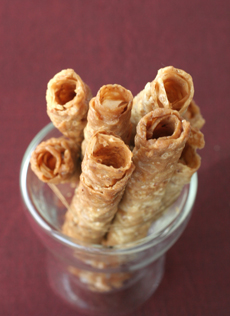
Minnie Beasley’s almond lace cookies rolled into a cigar shape. Photo by Michael Steele | THE NIBBLE. |
FLORENTINE WEDDING CAKE
A type of meltaway (which is a type of butter cookie) that is similar to the Mexican wedding cake, except that almond extract is added in addition to the vanilla extract, and toasted hazelnuts are substituted for the walnuts. The cookies are rolled in confectioners’ sugar like Mexican wedding cakes, but the tops are dusted with unsweetened cocoa powder as well.
FLUTE COOKIE
A rolled wafer cookie.
FONDANT
Fondant has often been called edible Play-Doh. It is a sugar and water mixture cooked to the soft-ball stage, then stirred or beaten until it is a creamy, opaque white mass that can be rolled out like dough. Marshmallow fondant is a variation. Sheets of fondant are used to cover ornate cakes. The fondant, which can be tinted with food color, can be cut with cookie cutters or other methods to create shapes (leaves, flowers, geometrics). It is also used to decorate cookies, often cut to match the shape of the cookies, and applied as an icing.
|
|
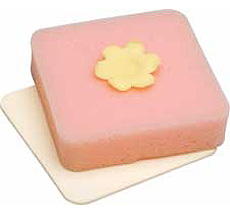
Pink fondant and a cut-out fondant flower decorate a cookie. Fondant available from Wilton.com. |
Working with fondant is a laborious process, undertaken by skilled cake decorators, but consumer products from Wilton and other companies make decorating with colored fondant a fun experience.
FORTUNE COOKIE
The history of the fortune cookie is a short one—no ancient Chinese treat, it’s less than 100 years old. The fortune cookie is an American invention. Chinese Americans call them “fortune cookies” since there is no Chinese word for them. In one version of the cookie’s origin, Makoto Hagiwara of Golden Gate Park’s Japanese Tea Garden invented them in San Francisco in 1909. In another version, David Jung, founder of the Hong Kong Noodle Company in Los Angeles, invented fortune cookies in 1918.
|
|
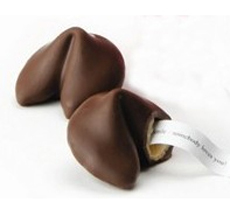
Chocolate-dipped fortune cookies from SwissMaid.com. |
Some people compare fortune cookies to the lotus-paste moon cakes of 12th- and 13th-century China. Soldiers tucked rice paper messages into moon cakes to help coordinate their attack against the Mongolian invaders. According to legend, the Mongolians had no taste for lotus nut paste and wouldn’t eat moon cakes; the moon cakes, containing instructions for the uprising which ultimately formed the basis of the Ming Dynasty, were thus easily handed out to the Chinese people with impunity. The American fortune cookies contain a slip of paper with a string of numbers (used by some as lucky lottery numbers) and a Chinese proverb or a prediction—the original “fortune” (“You will find happiness in a surprising place”). Today, a Chinese word or phrase with translation is often included in our global economy; learning Chinese trumps proverbs and predictions. Here’s a fortune cookie recipe.
FRIANDISES
From the French for “delicate,” this term for miniature cookies and confections served after dessert is used interchangeably with mignardises and petit-fours.
FRIED COOKIE
One of the eight basic types of cookies, a fried cookie is simply fried dough, often dusted with powdered sugar. Examples include the Jewish/Polish krusczyki, the Italian zeppole, and Mexican churros. Fried dough is becoming increasingly popular, with chocolate chip cookie dough, oatmeal cookie dough, and others all tossed into the fryer. Churros and other classic fried cookies are also finding their way onto the dessert menus of fine restaurants, served with chocolate dipping sauce.
Go To Next Page: Terms With G & H
Go To The Article Index Above
|
|
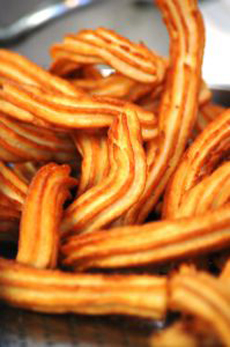
Churros. Photo by Nathalie Dulex | SXC. |
Lifestyle Direct, Inc. All rights reserved. Images are the copyright of their individual owners.

|











